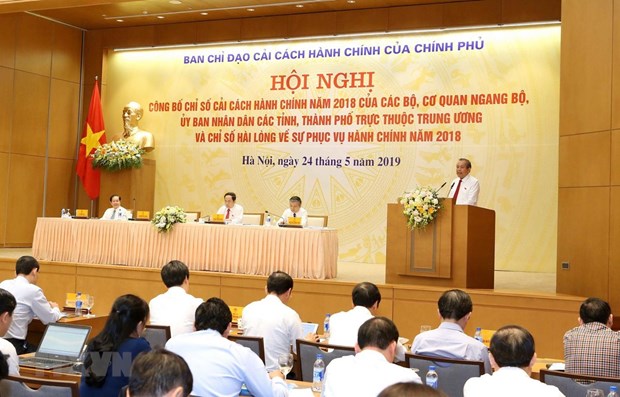Quang Ninh, central bank lead 2018 administrative reform index
 Deputy Prime Minister Truong Hoa Binh speaks at the event (Photo: VNA)
Deputy Prime Minister Truong Hoa Binh speaks at the event (Photo: VNA) The index polled 18 ministries and agencies in seven fields, and 63 cities and provinces in eight fields.
As a result, 14 ministries and agencies met over 80 percent of criteria in the index, including the SBV; the ministries of finance, justice, agriculture and rural development, industry and trade, foreign affairs, science and technology, home affairs, natural resources and environment, labour – invalids and social affairs, education and training, culture-sports-tourism, and planning and investment, and the Government Inspectorate.
The ministries of construction, information and communications, public health and transport were rated between 70 and 80 percent.
The SBV scored the most with 90.57 percent while the Transport Ministry achieved the lowest with 75.13 percent.
In the category of localities, Quang Ninh continued to lead the index with 89.06 percent, 5.08 percent higher than Hanoi with 83.98 percent.
The Mekong Delta province of Dong Thap ranked third, achieving 83.71 out of 100 points. The central city of Da Nang and the northern province of Hai Phong was placed fourth and fifth, respectively.
Among five localities in the bottom of the index, three got an index of below 70 percent, including the central province of Phu Yen (69.53 percent), the Central Highlands province of Kon Tum (69.57 percent) and the southern province of Tra Vinh (69.85 percent).
According to the 2018 Satisfaction Index of Public Administration Services (SIPAS) released by the committee the same day, the citizen satisfaction towards the delivery of public administration services averaged 82.99 percent.
The lowest score was 69.98 percent while the highest was 97.88 percent. Half of localities nationwide recorded an index of 81.92 and 97.88 percent while the remaining was between 69.98 and 81.92 percent.
Public satisfaction towards access to services, administrative procedures, officials, reception and settlement of public feedback was 80.62 percent, 86.4 percent, 85.1 percent. 88.13 percent and 74.07 percent, respectively.
Compared to 2017, the SIPAS 2018 rose by over 2 percent.
Speaking at the event, Deputy Prime Minister Truong Hoa Binh, who is also head of the committee, lauded ministries, agencies and localties for improving business climate and labour output, towards achieving the level of ASEAN 4 countries in terms of competitiveness and business environment.
He asked them to spread effective models in administrative reform, improve the quality of policymaking, uphold the role of the Government’s Advisory Council for Administrative Procedure Reform in enhancing dialogues with the business community and units concerned to promptly remove their difficulties, streamline administrative units in a more efficient way, strictly discipline violations in recruitment, appointment and rotation of officials and cadres.
They were also required to develop e-government while regularly improving online public services at level 3 and 4.
Quang Ninh topped Vietnam’s Provincial Competitiveness Index (PCI) 2018.
According to the PCI 2108 report launched on March 28 by the Vietnam Chamber of Commerce and Industry (VCCI) and the US Agency for International Development (USAID), Quang Ninh province gained the highest score of 70.36 on a 100-point scale.
This is the second consecutive year Quang Ninh has obtained the position. It is followed by the southern province of Dong Thap with 70.19 points and the Mekong Delta province of Long An with 68.09 points.
The PCI 2018, the 14th iteration of the report, was based on rigorous surveys of the perceptions of more than 12,000 firms operating in Vietnam, including nearly 11,000 private companies, in 63 cities and provinces and more than 1,500 foreign-invested enterprises in 20 localities.-VNA













